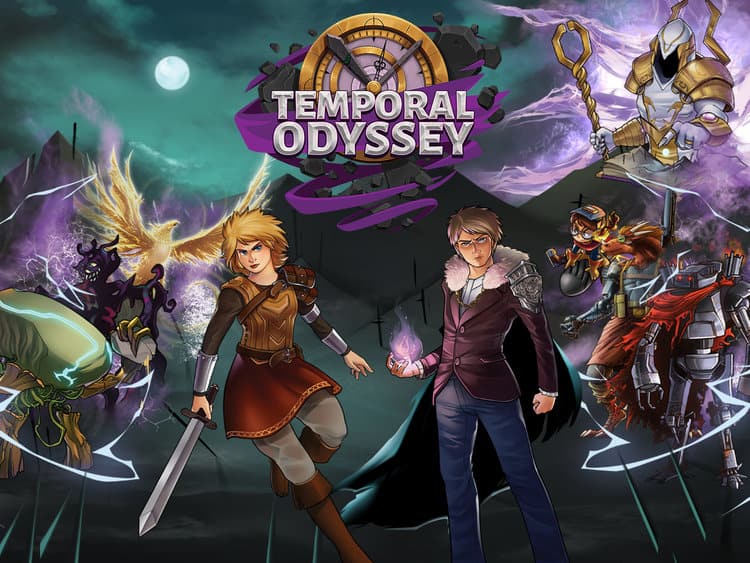Temporal Odyssey is a 2 player card dueling game (4 players with a team variant), designed by Chris Solis and published by CGC Games and Level 99 Games. Art provided by Adrienne Mata.
—
Magic the Gathering, the long reigning and undisputed king of card dueling games, continues to attract millions of players around the world. However, along with attracting lots of folks, it also repels its share of players, with a cumbersome, intimidating metagame, pay-to-win tendencies, and other significant barriers to entry.
As long as MtG has been around, we’ve gotten tons of alternative card dueling games to compete for your attention. Some noteworthy ones have been Summoner Wars and Ashes from Plaid Hat Games, Ascension from Stoneblade Games, Epic from White Wizard Games, and Codex: Card-Time Strategies from Sirlin Games. Level 99 Games, one of the publishers of Temporal Odyssey, has Exceed, an expandable dueling game with a ‘Street Fighter’-esque vibe.
Temporal Odyssey situates itself right in the middle of this very crowded field of card dueling games, offering a time travel theme, card drafting mechanisms, and a unique take on tactical maneuvering of the cards. Is that enough to make it stand out from the pack?

How to play Temporal Odyssey
Travelers: Every character, called a Traveler, beings with basically the same resources. All Travelers are represented by individual cards on the table with 30 attack and 50 health. In the economy of Temporal Odyssey, that represents very good attack and middling health. To balance, most characters also start play with a Tower card that provides big, fat, chunky defense for your Traveler to hide behind.

Characters/ Structures, Artifacts, and Spells: Along with your Traveler and Tower, you also start with six starter cards that can be grouped in three general categories. Character and Structure cards act like your Traveler card – once played, they are able to attack, use powers, and suffer damage.
Artifacts cards are special in that you play them and they hang around, but they may not be attacked.
The weenie Artifacts in your starter deck only provide color symbols, but you can get really powerful, almost game breaking Artifacts later.
The color symbols on the Artifacts (and also the improved, drafted cards you get later) interact with your last set of cards, your Spell cards. If you have the requisite colors in your growing tableau, you can cast different effects as one shots. The more symbols you have on the board, the more you powerful your spell can become.
Actions: You get four actions per turn. With those actions, you can play cards (more powerful cards take more actions to play), attack your opponents, cast spells, and activate abilities on the cards in your tableau. None of this is earth-shattering stuff, at least in the context of card dueling games.
However, the Regroup phase after the main action phase feels more unique. For every card in your tableau, you can pair them with another card to set up a defensive formation. Opponents can only attack the front card in the pair and cannot attack the back card. Further, if you attacked with a card that turn, it must be grouped in the front. Further, further, that back card often has a defensive power that can protect both cards – things like damage reduction, retribution damage, or evading the first attack entirely.
In terms of how Temporal Odyssey feels to play, the Regroup phase creates the most interest (at least for me). As mentioned above, your main Traveler card is often your best attacker. How long can you afford to cower behind your tower and let lesser cards do the attacking? When is it worth using your main character to attack, thereby exposing your main character to reprisal? Can I sneak an attack in there on a turn where my opponent has other priorities and won’t attack me?
When you’re main character hits 0 hp, it isn’t the end of the world. However, you do get much closer to your doom. More on that in a bit.
Drafting more cards: At the end of your turn, you pick one of three different stacks in the market called the Past, Present, and Future, then draw three cards. You keep one, discard one, then make one available on top of the deck for the next player. It’s not a direct draft, like in 7 Wonders. Therefore, you don’t get quite the same “I hope I don’t give my opponent something too good” tension that comes from a direct draft system. That player might just skip past the card you left and draw from another deck. However, you are leaving something, and you need to be mindful of what you leave because an experience player might pounce and use it against you.

At the beginning of the game, you construct the Past, Present, and Future piles using different faction groups. For example, you can choose among Ancients, Beasts, Golems, Elementals, and other factions for the Past deck, or Mechs, Engineers, etc. for the Future deck. The base box for Temporal Odyssey has more factions than you need for any particular game, so you can swap factions out and create a lot of replayability that way.
Winning and Losing: When your Traveler reaches 0 hp, you flip his/ her card. Usually, that means you gain an Instability card, which is your timer. If you get three such cards and your Traveler hits 0 hp, then you lose the whole game. You can also get Instability cards from having too many other cards destroyed, or from the most powerful Artifact attacks in the game.
I omitted some rules here or there. And I definitely did not go over all of the different powers, spells, and combos presented by the advanced cards. However, I hope this gives enough of a sense of how to play Temporal Odyssey.

What I liked about Temporal Odyssey
1) Cool style and art – Nine times out of ten in my written reviews, I talk about theme. Not here. The theme of time travel theme is basically non-existent. The Past, Present and Future are supposed to represent you ripping open time portals and drafting creatures across the multiverse. Not sure how you’re supposed to represent that in a card game, but this isn’t it.
However, I don’t regard that as a negative. I don’t think the point of the time travel theme is to make you feel like a time traveler. Instead, it allows artist Adrienne Mata to deliver some pretty cool pieces. There’s basically an unlimited pallate available, from medieval dragons to electrified mechs.
In addition, many of the cards do the same thing. In those cases, the game totally could have gotten away with repeating art assets to save cost. However, we instead get all unique and sometimes very cool art pieces. Kudos to production and to the effort that went into trying to make Temporal Odyssey stand out.

2) The Regroup Phase – I mentioned it above, but I think the point is really worth underscoring. In my opinion, very few card dueling games do it quite this way. Lots of other games have ways to trade damage, set up defenses, etc. The grouping system replicates skirmish-style play without needing to play on a grid, which is a neat trick. You can rotate who attacks and who takes cover, or turtle in different kinds of defenses, or go all out if you smell blood. If you miscalculate, the cards are right there for your enemy to kill off.
3) Satisfying Combos – If the tactical combat experience comes from the character cards, the combo-liciousness that we expect from these kinds of games comes from the spells. Spells grow in power as you grow your tableau to match the color combos you need. If you set it up right, you can easily do 100 or more damage with one action. A good dueling card game rewards cleverness and long term planning; Temporal Odyssey certainly delivers that.
4) Replayability and expandability – Level 99 publishes this game, so you know you’re going to get some expansions. The base box itself has double the needed faction cards for the Past, Present, and Future. So, you can play two completely unique games in a row. Start mixing them up, and you get a lot of variety.
I don’t know if there are any current plans for expansions, but any potential packs would seem to fit in with very little effort.
What I didn’t like about Temporal Odyssey
1) Accessibility issues – I’ve seen a few of the reviews for Temporal Odyssey so far talk about how easy it was to get into. I didn’t have that experience. In MtG, before you get into the huge metagame, you can get basic starter decks where many of the cards play in a straightforward way with no text – land that gives you mana, or 1/1 creatures that just sit there and do 1/1 things. Any reduction in reading overhead acts to reduce the mental load for a new player to the game. I, as a teacher, greatly appreciate that.
Here, though, pretty much every card has text on it which you need to be mindful of, even some of the weak starter cards. Once you start getting into the advanced decks, you can start stealing other people’s cards, transferring damage from card to card, and all sorts of other shenanigans. I found that even the suggested starter market cards threw gamers into the deep end.
Veteran card duelers should have few issues. However, I found it tough to teach folks who had less experience.
2) Wonky Balance with a Wonky Fix – Level 99 games seem to revel in players breaking their games with OMG combos and maneuvers to bring opponents to their knees. Temporal Odyssey is no different. If you figure it out, you can do some silly, frustrating stuff like create impenetrable walls of defense or summon game killing cards with very few actions. As rewarding as that can be for the player pulling it off, your opponent might not agree.
3 AP Artifact cards constitute the game’s great equalizers. Most of them give an opponent one instability instantly. No muss, no fuss. Basically, one card gets your 1/4 of the way to victory. And they have other powers! They effectively break turtle and buff strats, and they help people feel like they have a chance, even when they are behind. But its a solution that feels more like a hammer than a scalpel.
Final Verdict
As someone who enjoys a good card dueler but who doesn’t want to get into Magic: the Gathering, I was hoping that Temporal Odyssey would provide a similar feel with less overhead and lower barriers. I would say that I had mixed results, in this regard. Issues of balance and accessibility were significant for me.
However, as a 2 player dueling game, I can say that I enjoyed my plays of Temporal Odyssey. It offers tactile, tactical play with only a deck of cards, as well as opportunities to pull off clever and satisfying combos. You also get a fair amount of bang for your buck with the base box. If you like the sound of all that and don’t mind all of the caveats, I can recommend Temporal Odyssey.





Show Comments